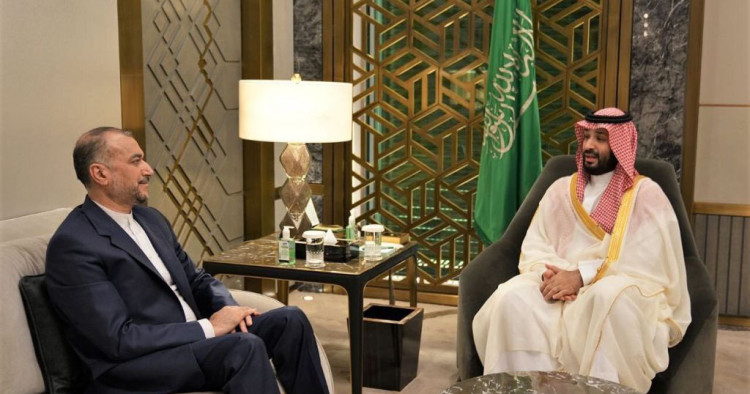Contents:
- Saudi-Iran rapprochement amid regional and global shifts
- Despite re-engagement by Arab governments, Syria’s Assad presides over a collapsing state
- Amid record-high temperatures, wildfires scorch the Mediterranean
- Despite pause in Tripoli violence, Libya’s future remains at an impasse
- Pakistan’s new caretaker government and what it tells us about the country’s political future
Saudi-Iran rapprochement amid regional and global shifts
Ross Harrison
Senior Fellow and Book Series Editor
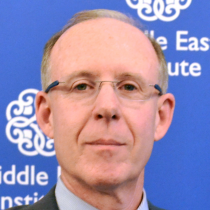
-
Iranian-Saudi rapprochement is driven by growing recognition of the need for collective action to resolve transnational security problems as well as important shifts in global and regional political conditions.
-
Given how destabilizing Iranian-Saudi hostility has been, even a mere reduction in tensions, efforts to alleviate the suffering of Yemenis, and some cooperation on climate related issues, could be sufficient to offer net benefits to the region.
The spotlight this past week was on Iranian Foreign Minister Hossein Amir-Abdollahian’s visit to Riyadh to meet Saudi Crown Prince Mohammed bin Salman. While the countries reestablished diplomatic relations that were broken in 2016, it remains to be seen how enduring the rapprochement will be. With no new agreements announced in Riyadh, it is still unclear how far resolving their differences over Yemen will go, or whether Iran will continue to poke at Riyadh by supporting Shi’a protests in Bahrain. On the Saudi side, little progress seems to have been made on the much-ballyhooed prospects for investments in Iran, discussed when the deal was consummated in Beijing last March.
But looking at the Iranian-Saudi relationship in the context of changed regional and global conditions should temper our skepticism about the talks. First, there is a growing recognition by both countries that problems like climate change and security can only be solved through collective action. Also, a trend toward empowerment of regional actors rather than an overreliance on outsiders creates a sense of urgency for continued diplomacy between Iran and Saudi Arabia. This trend was reinforced by the region’s civil wars, which, a decade ago, drew Iran, Saudi Arabia, and other regional powers into a conflict trap but are now creating imperatives for tension reduction and reconstruction. Iraq, previously racked by civil war and having suffered from the toxicity of poor Saudi-Iranian relations, was responsible for opening the diplomatic track between Iran and Saudi Arabia. It was only later that talks moved to Oman and, ultimately, to China. Also, diplomacy is in the air across the region. Turkey and Egypt just renewed their relationship, which had been on the rocks since 2013. And the Abraham Accords, between Israel, the United Arab Emirates, and Bahrain, signal a recognition that economic interests can trump geopolitical and ideological differences.
Second, global shifts have also provided the context for continued talks between Tehran and Riyadh. China’s role in brokering the bilateral deal makes it politically more difficult for either side to wriggle out of its commitments. Moreover, the war against Ukraine has isolated Russia and, by extension, its Iranian ally. Given the war and the narrowing of a diplomatic path between Iran and the United States, Tehran sees its relations with its Gulf Arab neighbors as the only way to break out of isolation. Also, Washington’s parallel effort to get Saudi Arabia and Israel to normalize relations certainly gives the Iranians an incentive to act with a modicum of good faith. And on the Gulf Arab side, questions about continued U.S. commitments signal to Riyadh that diplomacy with Tehran might be the only way to ensure their security.
It is quite possible that the normalization of relations won’t meet initial expectations of economic and political benefits. But given how destabilizing the hostility between Iran and Saudi Arabia has been to the region, a mere reduction in tensions, efforts to alleviate the suffering of Yemenis, and some cooperation on climate related issues, could be sufficient to offer net benefits to the region. While there will be differences that will likely preclude a blossoming of a warm peace, changed regional and global conditions should act as a glue that keeps the arrangement from coming completely undone.
Despite re-engagement by Arab governments, Syria’s Assad presides over a collapsing state
Charles Lister
Senior Fellow, Director of Syria and Countering Terrorism & Extremism programs
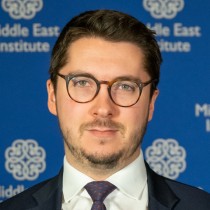
-
The regional initiative to re-engage Bashar al-Assad’s regime can best be described as an unmitigated disaster, and, since April, every facet of Syria’s crisis has taken a nosedive.
-
The idea that Assad and a re-empowered “strong state” somehow offers Syria its best chance of recovery is patently and irrefutably absurd.
Four months ago, Saudi Foreign Minister Faisal bin Farhan visited President Bashar al-Assad in Damascus, re-establishing diplomatic ties with Syria for the first time since 2011. The dramatic move was the pinnacle of a regional “initiative” to re-engage Assad’s regime, to normalize its status within the Middle East, and to pave a path toward resolving Syria’s crisis and bringing stability to a country torn apart by 12 years of brutal conflict.
Four months later, the regional initiative can best be described as an unmitigated disaster. Since April, every facet of Syria’s crisis has taken a nosedive. Everything that regional states had sought to make progress on — from enabling refugee returns, to stemming the regime-coordinated drug trade, to improving humanitarian conditions — has dramatically deteriorated. A regional follow-up meeting convened on Aug. 15 to assess progress did nothing more than reiterate lofty ambitions, while ignoring reality altogether.
Most significantly, Syria’s economy has collapsed. Despite receiving a surge of regional funds facilitated by post-earthquake Western sanctions waivers, the Syrian pound has lost 100% of its value since the Saudi foreign minister visited Damascus. The past month has seen the currency reach levels nearing hyperinflation. With 90% of Syrians already living under the poverty line and the cost of living surging, Assad sought to placate bubbling frustration on Aug. 15 by announcing a doubling of public sector salaries. But in typical fashion, seven minutes later, he announced hikes in diesel and gasoline prices of 300% and 170%, respectively.
Within 24 hours, people began taking to the streets in regime-held areas in rare protest. For five days, the southern governorate of al-Suwayda has been gripped by a general strike. Civilians have forcibly shut every road leading to Damascus, and Druze clerics have joined the demonstrations, calling for “the downfall of the regime” and pledging unity with Idlib “until death.” In Daraa governorate, anti-regime protests are now in their sixth day in at least 15 localities. There, anti-regime fighters can be seen amid the demonstrations. Several Damascus suburbs, including Jaramana and Kafr Hawar, have also hosted anti-regime protests, and graffiti calling for Assad’s overthrow has emerged in Homs. In the Alawite heartlands of Latakia, one pro-regime militia leader posted a videotaped speech accusing Assad and his wife, Asma, of “forcing” Syria’s people “into destitution,” while two Alawite activists have been disappeared for posting their own anger on social media.
As regime-manufactured drugs continue to flow across the region and Syrian refugees board rickety boats toward Europe in ever-greater numbers, violence is also escalating inside the country. In the past week alone, ISIS has killed at least 35 pro-regime fighters in a string of attacks in Deir ez-Zor and outside Palmyra. Russian jets resumed airstrikes in Idlib, targeting a public swimming pool and a farm, and Turkish aircraft have killed Kurdish militants operating in regime-held areas of Aleppo as well as several regime soldiers in recent days.
There is an argument to be made that Assad’s regime may never have been existentially threatened by armed revolution, given the predictable loyalties of its external patrons Russia and Iran. But Assad has no such protection when it comes to the challenge of financial devastation. Despite the recent promise of Gulf investments in exchange for piecemeal domestic reforms, Assad has proved as obstinate as ever — driving his country ever deeper into ruin.
One thing stands truer today than ever: The idea that Assad and a re-empowered “strong state” somehow offers Syria its best chance of recovery is patently and irrefutably absurd.
Follow on Twitter: @Charles_Lister
Amid record-high temperatures, wildfires scorch the Mediterranean
Gökçe Şencan
Non-Resident Scholar

-
The Mediterranean is emerging as a climate change hotspot, with warmer weather and truncated rainy seasons causing annual wildfire conditions to materialize earlier and more acutely.
-
The deadly combination is devastating Mediterranean ecosystems and threatening the health, safety, and livelihoods of more than half a billion people in 22 countries; taking proactive mitigation and adaptation measures will be critical.
European scientists recently declared July 2023 the world’s hottest month on record, and the impacts of this heat were widespread in the Mediterranean. Heatwaves have been breaking all-time temperature records in Southern Europe and North Africa, and wildfires erupted across the region. Deadly blazes in Algeria, Greece, Italy, and other Mediterranean countries killed dozens of people and consumed forests, shrublands, towns, and livelihoods.
Mediterranean ecosystems are generally adapted to wildfire, which is a natural part of the region’s climate: Some pinecones release their seeds only when exposed to fire or very high temperatures, and many shrubs can resprout from their roots following a fire event. But the unprecedented scale and intensity of the current fires risk the recovery of these precious habitats. The Mediterranean is emerging as a climate change hotspot: Warmer weather throughout the year and truncated rainy seasons are causing wildfire conditions to materialize earlier and more acutely. More frequent and severe summer heatwaves are rendering forests more vulnerable to diseases and beetle infestations. Climate change also fuels prolonged dry periods, like the one plaguing parts of the region since 2020. As trees and other vegetation dry out and die from heightened water stress, they become more combustible and likely to fuel wildfires.
Following the abnormally intense wildfire seasons in the Mediterranean in 2021 and 2022, the deadly combination of heat and wildfires is devastating Mediterranean ecosystems and threatening the health, safety, and livelihoods of more than half a billion people in 22 countries and three continents. These countries could significantly benefit from pooling their resources and coordinating a regionwide unified response to these climate phenomena.
Taking proactive measures to limit the impact of heatwaves and wildfires is also critical. For heatwaves, governments can issue heat warnings, establish cooling centers in public buildings, and enhance green spaces (particularly in major cities) to help individuals, especially those at risk, stay safe. For wildfires, prescribed burns and removing dead trees could help clear dry vegetation and reduce wildfire risk. Communities near forests with high wildfire risk should prepare evacuation plans. Diseases and infestations in such forests should be monitored and managed through preventative measures and treatments.
Heatwaves and wildfires will continue to be a serious threat to the Mediterranean in the coming years. But the extent to which the region will be affected by their impacts depends on whether regional countries can come up with a cohesive and synchronized climate adaptation plan.
Follow on Twitter: @GokceSencan
Despite pause in Tripoli violence, Libya’s future remains at an impasse
Jonathan M. Winer
Non-Resident Scholar
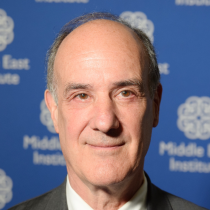
-
Last week’s deadly clashes between two Libyan militias followed a cascade of destabilizing events, beginning with the Tobruk-based House of Representatives and the Tripoli High State Council agreeing last month to a new and deeply flawed political road map to elections.
-
For any road map to actually result in elections rather than more internal turmoil, the U.N., major international actors, and Libyan political leaders will all need to decide that no alternatives are workable.
Last week’s fighting between two militias in Tripoli, killing at least 55 people over Aug. 14-15, was merely another domino to fall in a cascade of destabilizing events that began in July. That month, the heads of Libya’s Tobruk-based House of Representatives (HoR) and the Tripoli High State Council (HSC) agreed to a new and deeply flawed political road map to elections that would begin by replacing Libyan interim Prime Minister Abdul Hamad Dbeibah with someone more to their liking. In response, the United Nations’ Special Envoy for Libya Abdoulaye Bathily called the road map unworkable and accurately predicted it would lead to violence.
But rather than acquiescing to the plan to get rid of him, Dbeibah retaliated by securing the removal and replacement of the head of the High State Council, Khalid al-Mishri. Then, Dbeibah used the 444 Brigade militia, controlled by Mahmoud Hamza, to further consolidate physical control over critical infrastructure in Libya’s west to supplement his use of patronage for retaining political control. This in turn led to last week’s deadly clashes, when the Islamist RADA Special Deterrence Forces, run by Abdul Raouf Kara, arrested Commander Hamza, triggering militia-on-militia violence until his Aug. 16 release, following a direct intervention by Dbeibah.
The specific terms of any deal between Dbeibah and Kara aren’t known. Yet the bottom line is that Kara wants to ensure no one is able to challenge the RADA’s monopoly on power or the money generated from their control of Tripoli’s only operational international airport (Mitiga), the local prison, and related resources.
It’s more difficult to assess whether the interests of other actors, such as Khalifa Hifter, Libya’s principal eastern warlord, played into this latest militarization of Libyan politics. In recent weeks, Hifter again aligned himself with those wanting to counter Dbeibah’s ability to remain in power for the foreseeable future.
For any road map to actually result in elections, the U.N., major international actors, and Libyan political leaders will all need to decide that no alternatives are workable. Alternatives include (1) installing a new, third, transitional national unity government, handpicked by the HoR and HSC; (2) keeping the status quo of divided government under Dbeibah in the west and Hifter and his family in the east; and (3) further chaos and violence whenever existing arrangements break down. Of the four options, agreement on parliamentary or presidential elections anytime soon would seem to be the least probable scenario.
Unconfirmed press reports suggest that international governments and organizations, led by the U.N., are preparing to gather in Paris soon for discussions on a way forward. As of today, none is visible, despite one promising event: the Aug. 20 announced reunification of Libya’s Central Bank, hailed as a model that could potentially be emulated by other Libyan institutions. Here’s hoping.
Follow on Twitter: @JonathanMaWiner
Pakistan’s new caretaker government and what it tells us about the country’s political future
Syed Mohammad Ali
Non-Resident Scholar
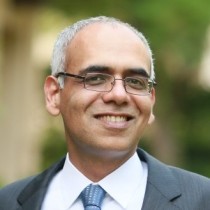
-
The reins of power have been handed over to a caretaker government under former Senator Anwar-ul-Haq Kakar, who is widely considered to be close to the military.
-
General elections were meant to be held within three months, but a recent decision by the election commission suggests that they may be postponed until early next year, at least.
With the dissolution earlier this month of the coalition government that had ousted Prime Minister Imran Khan via a no confidence vote back in April 2022, the reins of power have been handed over to a caretaker setup. Caretaker governments in Westminster-style parliamentary democracies are usually comprised of the incumbent government operating with constrained powers until a new government can be formed. The caretaker setup in Pakistan, however, is uniquely made up entirely of non-elected officials, who establish both federal and provincial level governments, until new elections are held.
The system was first introduced by President and General Zia ul-Haq in 1985, prior to the formation of new assemblies via non-party-based elections. Despite the apparent rationale for forming a caretaker setup comprised of technocratic and “neutral” individuals until a new government is elected, most of the seven prior interim governments had identifiable biases that undermined their credibility.
The next general elections were supposed to be held in Pakistan within three months, but the recent decision by the country’s election commission to draw fresh constituencies using the new census suggests that they may be postponed until early next year, at least.
The formation of a caretaker government headed by former Senator Anwar-ul-Haq Kakar, an ethnic Pashtun from the restive state of Balochistan, is not without contention. Kakar is widely considered to be close to the military. He set up the pro-establishment Balochistan Awami Party in 2018 as well as the pro-establishment non-governmental organization Voice of Balochistan. Other members of the federal and provincial cabinets include political personalities with close ties to mainstream parties, barring Khan’s Pakistan Tehreek-e-Insaf (PTI) party. A former Pakistani ambassador to the United States, Jalil Abbas Jilani is the caretaker foreign minister. Shamshad Akhtar, a former governor of the State Bank of Pakistan, has been given charge of the finance ministry. The cabinet also includes Mishaal Malik, the wife of a jailed Kashmiri leader, as a human rights minister, which is an interesting move guided perhaps by the military’s resolve to draw attention to the plight of Kashmiris across the border in India. Moreover, the large, two dozen-member cabinet also includes ministers for non-essential departments, such as culture and tourism, further fueling suspicions that the caretaker setup may last for a while.
The caretaker government has recently been given powers to make economic decisions, especially to enable the inflow of desperately needed foreign loans. Thus far, this interim setup is focusing on issues of most relevance to the military, such as endorsing the need for accountability of alleged instigators of riots this past May, which also targeted military buildings. In addition, the caretakers have called out the president for not endorsing laws meant to give more powers to the military and to its intelligence agencies. While any caretaker arrangement is meant to relinquish power after three months, it seems that this newly formed government may stay put until the military can figure out a power-sharing formula that enables it to continue exerting influence over the country’s political-economy.
Photo by Iranian Foreign Ministry / Handout/Anadolu Agency via Getty Images
The Middle East Institute (MEI) is an independent, non-partisan, non-for-profit, educational organization. It does not engage in advocacy and its scholars’ opinions are their own. MEI welcomes financial donations, but retains sole editorial control over its work and its publications reflect only the authors’ views. For a listing of MEI donors, please click here.












